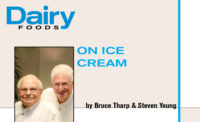This past year, we have reflected together and individually on technical and non-technical considerations involved with formulating “clean-label” ice creams and related products.
A year ago, (Dairy Foods, February 2017) we noted in this column that “a conundrum exists.” There is the consumer’s perception that being transparent, simple, wholesome and understandable is good (i.e., “clean” labeling). But the technical demands and limitations of economically delivering good-quality ice cream of varying compositions in various forms to various points of consumption under varying conditions may or may not be wholly compatible with “clean labeling” considerations.
The evolution of contemporary ice cream with regard to mix composition, mix processing, whipping/freezing and distribution systems has resulted in quality improvements and other desirable elements of structure. However, at the same time, new demands on heat-shock resistance arose. These factors, in turn, have led to more technically astute and innovative selection and use of ingredients, mix compositions, and mix-making/processing approaches, as well as novel approaches to whipping, freezing and hardening.
As a result, ingredient lists have become longer (as novel, functionally superior ingredients have been developed and applied), in some instances with more complex ingredient terminologies, to conquer a variety of sensory, distribution, storage, nutrition labeling and food safety challenges. This results in the application of more ingredients of varying sources, complex functionalities and terminologies to protect the sensory appeal of finished ice cream through the entire expected shelf life of the finished food.
Today, marketplace demand, the technical “rules-of-the-road” and inherent limitations seem very much the same as they did in 2017:
- Ice cream and related products remain inherently complex as the only frozen foods that are intended to be consumed frozen. They must be delivered as having some components in true solution, some insoluble, some in colloidal suspension, some in fat/oil-in-water emulsion and some with all three forms of water — liquid, solid and vapor — and all within a stable foam.
- Marketplace demand for clean-labeled products continues to grow. Considering the special nature and demands of frozen desserts, the more sensitive they are to the rigors of distribution/storage (i.e., “heat shock”), the less their net sensory appeal.
- The pressure on economic viability in a competitively challenging market environment is not likely to abate. New challenges arise every day, including but not limited to the highly variable costs of flavors, inclusions and colorants.
But there have been some developments since last we “met” in this column, including:
- Novel ingredients with associated market positioning, new approaches, functionalities and consumer benefits. Look for further development of novel, functionally advanced ingredients and application approaches.
- New products, formats, forms and flavors, including clean-label demands on characterizing flavors and particulate and/or syrup inclusions. This includes management and possible reformulation of flavors and product lines to be fully consistent with clean-label initiatives.
- Growth of dairy and non-dairy frozen desserts. With plant-based frozen desserts being of current interest, the same laws of chemistry and physics that affect dairy frozen desserts may need to be applied differently and with different degrees of care.
- The growth of organic, non-genetically modified and more “natural” sources of ingredients, all in a cost-competitive environment.
- Novel approaches to packaging (downsizing of multiple-serve and single-serve units). The good news? Smaller packages offer potentially higher ROIs.
- Use of fewer mixes to deliver differing features/benefits.
- The changing regulatory environment. Serving sizes are expected to increase; ingredient and nutrition facts labeling is changing; and demands on food safety will expand. The latter will require management of chemical, physical and microbiological risks well beyond good manufacturing practices.
- Changing foodservice/retail environments at both point-of-sale and point-of-consumption locations.
The clean-label formulation focus remains the same — that is, management of total solids, total solids as milk-based (and non-milk based, as required) ingredients (including limitations, thereof), amount/type of sweeteners (and, thus, the amount/“quality” of sweetness applied), the need for properly selected bulking agents, and any added stabilization, emulsification, freezing-point management and related indices of texture stability and water mobility. All of these place sensory appeal and economic viability at risk.
All of the above considerations put multiple stresses on managing the laws of chemistry and physics and limit the ability to deliver multiple forms with multiple features (facts) with associated benefits (reasons to buy). It’s not easy managing multiple variables at once — for example, mix composition for freezing performance, overrun (including air bubble size/strength/integrity), sensory appeal (body, texture, flavor delivery) and economical formats and forms — while at the same time extending sensory appeal through the entire intended shelf life of the product(s) in question.
We are not sure if or when the demand for consumer-friendly clean-labeled ice cream will end, nor if any one approach, ingredient or process will resolve the conundrum we noted in 2017. Of course, we could very well come back in 2019 talking about the very same challenges to successful clean labeling of frozen desserts. Stay tuned for sure!
Note: This column was adapted, in part, from a presentation given at the “2017 Clean Label Conference” in Itasca, Ill.



